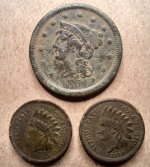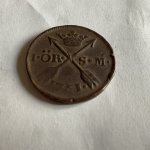Badger Bart
Sr. Member
- Mar 24, 2005
- 301
- 18
Spanish ship ruins exposed
Date published: 4/7/2006
By MELISSA NELSON
ASSOCIATED PRESS WRITER
PENSACOLA, Fla.--Navy construction crews have unearthed a rare Spanish ship that was buried for centuries under sand on Pensacola's Naval Air Station, archaeologists confirmed last week.
The vessel could date to the mid-1500s, when the first Spanish settlement in what is now the United States was founded here, the archaeologists said.
But the exposed portion looks more like that of ships from a later period because of its iron bolts, said Elizabeth Benchley, director of the Archaeology Institute at the University of West Florida.
"There are Spanish shipwrecks in Pensacola Bay," Benchley said. "We have worked on two--one from 1559 and another from 1705. But no one has found one buried on land. This was quite a surprise to everybody."
Construction crews came upon the ship this month while rebuilding the base's swim rescue school, destroyed during Hurricane Ivan in 2004.
The exposed keel of the ship juts upward from the sandy bottom of the pit and gives some idea of the vessel's form. Archaeologists estimated the rest of the ship is buried in about 75 feet of sand. (No wonder my two-boxer couldn't find it)
During initial work to determine the ship's origin, archaeologists found ceramic tiles, ropes and pieces of olive jars. The settlement was founded in 1559; its exact location is a mystery. The Spanish did not return until more than a century later in 1698 at Presidio Santa Maria de Galve, now the naval station.
The French captured and burned the settlement in 1719 but handed Pensacola back to Spain three years later. Hurricanes forced the Spanish to repeatedly rebuild.
The Navy plans to enclose the uncovered portion of the ship, mark the site and move construction over to accommodate archaeological work, officials said.
"We don't have plans to excavate the entire ship," Benchley said. "It's going to be very expensive because it's so deeply buried and we would have to have grant money," she said.
Date published: 4/7/2006 http://fredericksburg.com/News/FLS/2006/042006/04072006/178376?rss=local
Date published: 4/7/2006
By MELISSA NELSON
ASSOCIATED PRESS WRITER
PENSACOLA, Fla.--Navy construction crews have unearthed a rare Spanish ship that was buried for centuries under sand on Pensacola's Naval Air Station, archaeologists confirmed last week.
The vessel could date to the mid-1500s, when the first Spanish settlement in what is now the United States was founded here, the archaeologists said.
But the exposed portion looks more like that of ships from a later period because of its iron bolts, said Elizabeth Benchley, director of the Archaeology Institute at the University of West Florida.
"There are Spanish shipwrecks in Pensacola Bay," Benchley said. "We have worked on two--one from 1559 and another from 1705. But no one has found one buried on land. This was quite a surprise to everybody."
Construction crews came upon the ship this month while rebuilding the base's swim rescue school, destroyed during Hurricane Ivan in 2004.
The exposed keel of the ship juts upward from the sandy bottom of the pit and gives some idea of the vessel's form. Archaeologists estimated the rest of the ship is buried in about 75 feet of sand. (No wonder my two-boxer couldn't find it)
During initial work to determine the ship's origin, archaeologists found ceramic tiles, ropes and pieces of olive jars. The settlement was founded in 1559; its exact location is a mystery. The Spanish did not return until more than a century later in 1698 at Presidio Santa Maria de Galve, now the naval station.
The French captured and burned the settlement in 1719 but handed Pensacola back to Spain three years later. Hurricanes forced the Spanish to repeatedly rebuild.
The Navy plans to enclose the uncovered portion of the ship, mark the site and move construction over to accommodate archaeological work, officials said.
"We don't have plans to excavate the entire ship," Benchley said. "It's going to be very expensive because it's so deeply buried and we would have to have grant money," she said.
Date published: 4/7/2006 http://fredericksburg.com/News/FLS/2006/042006/04072006/178376?rss=local





